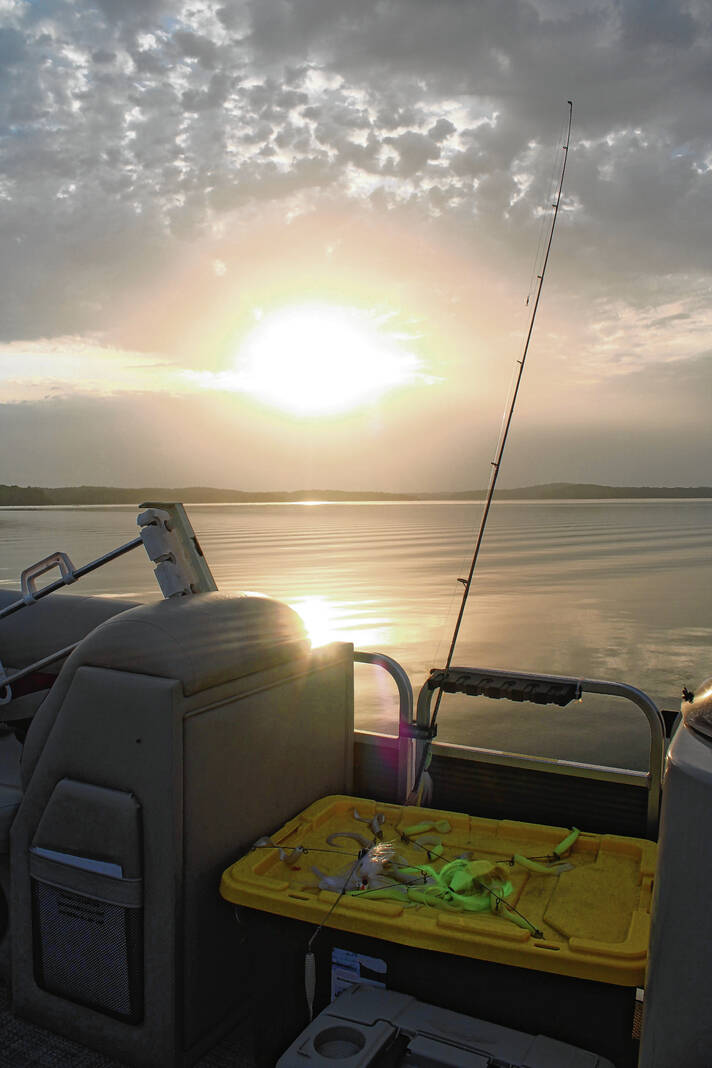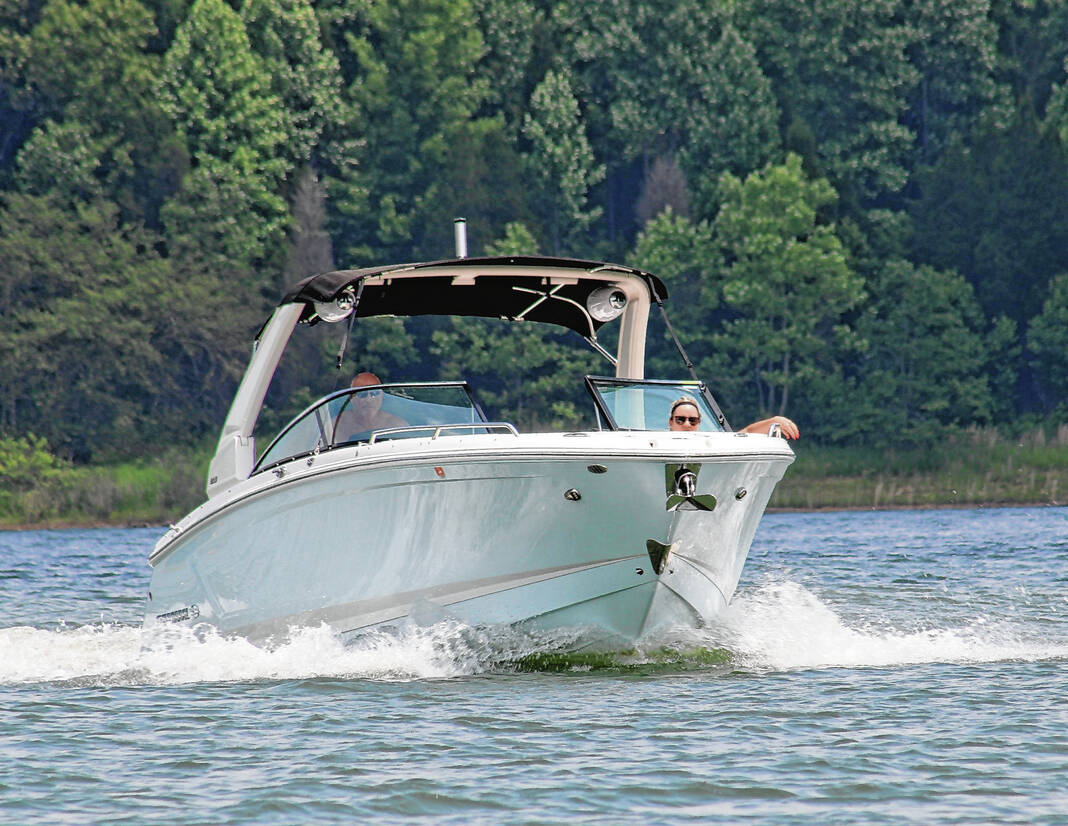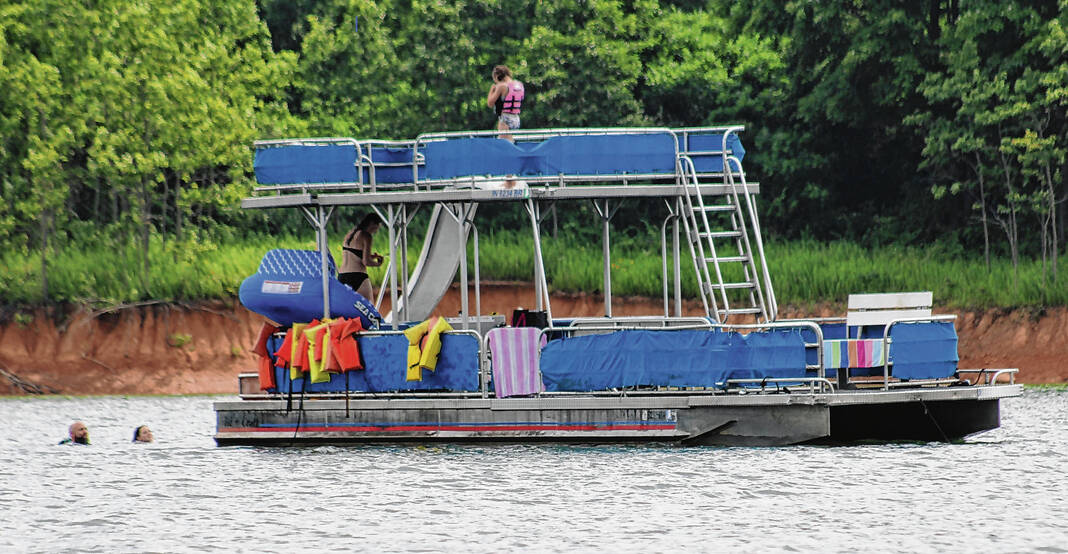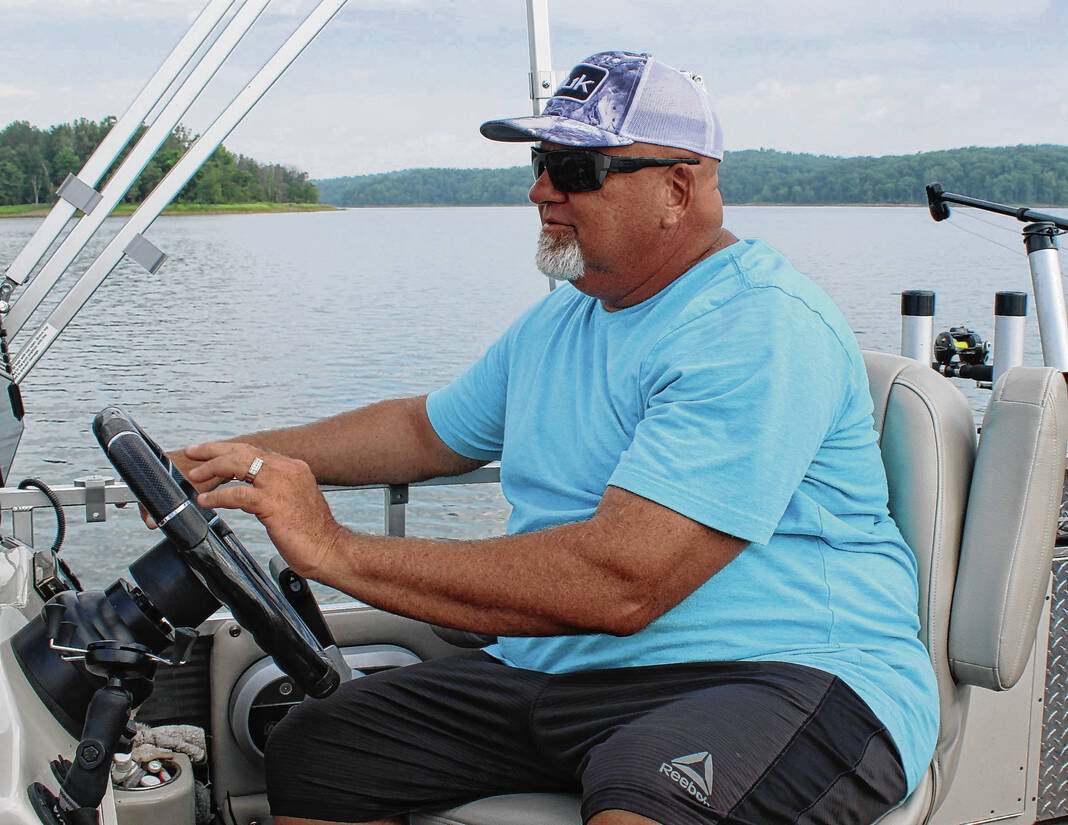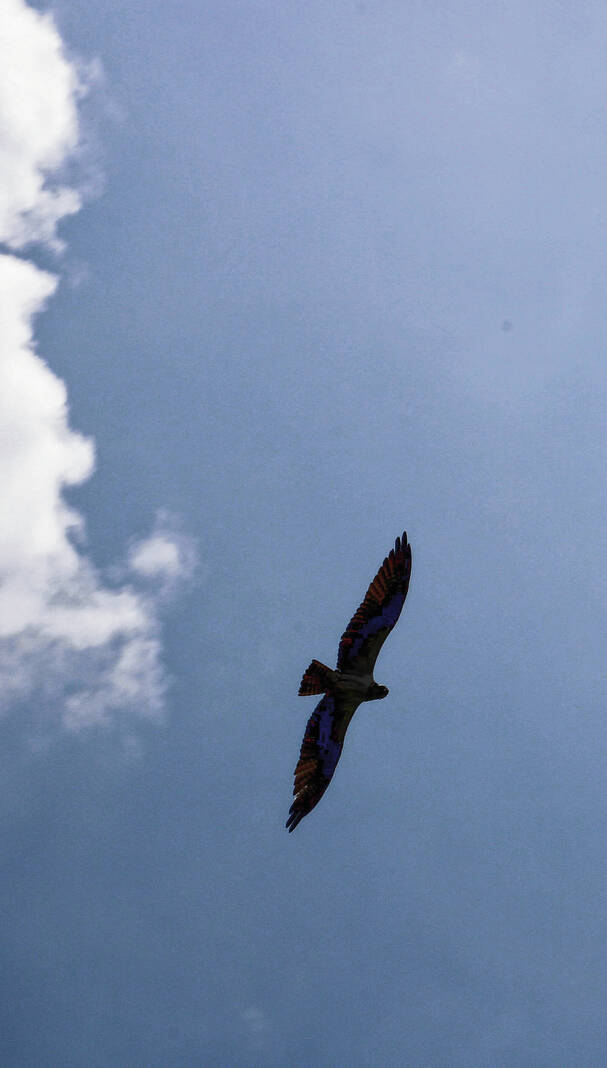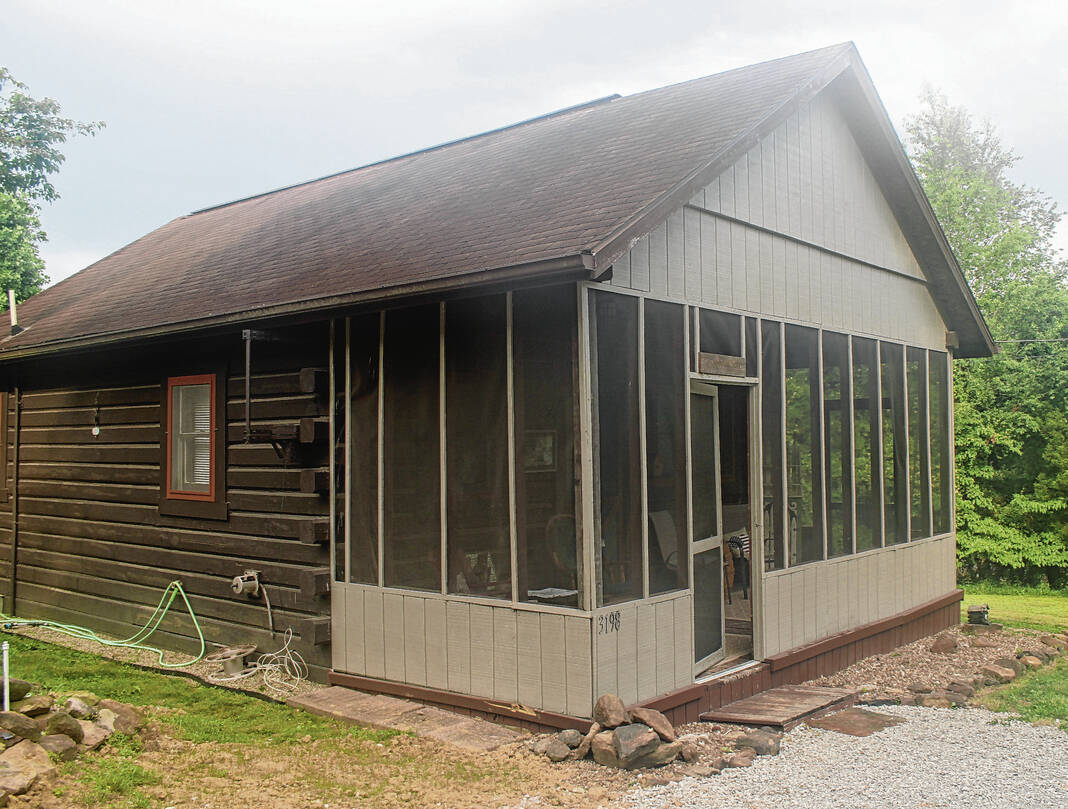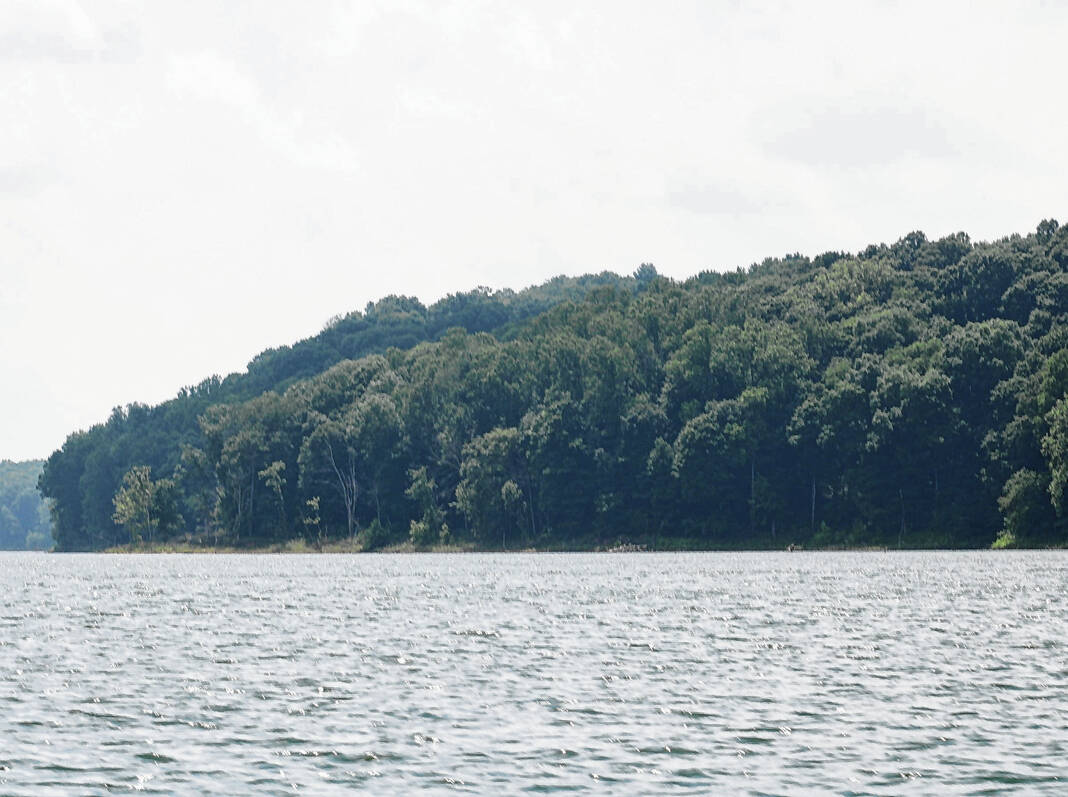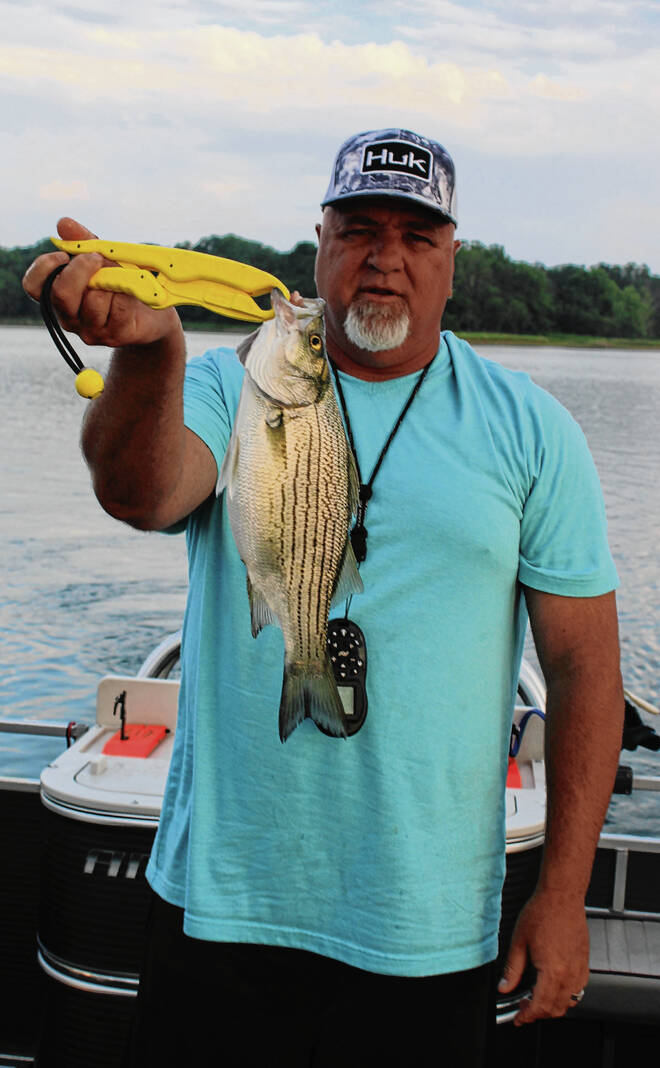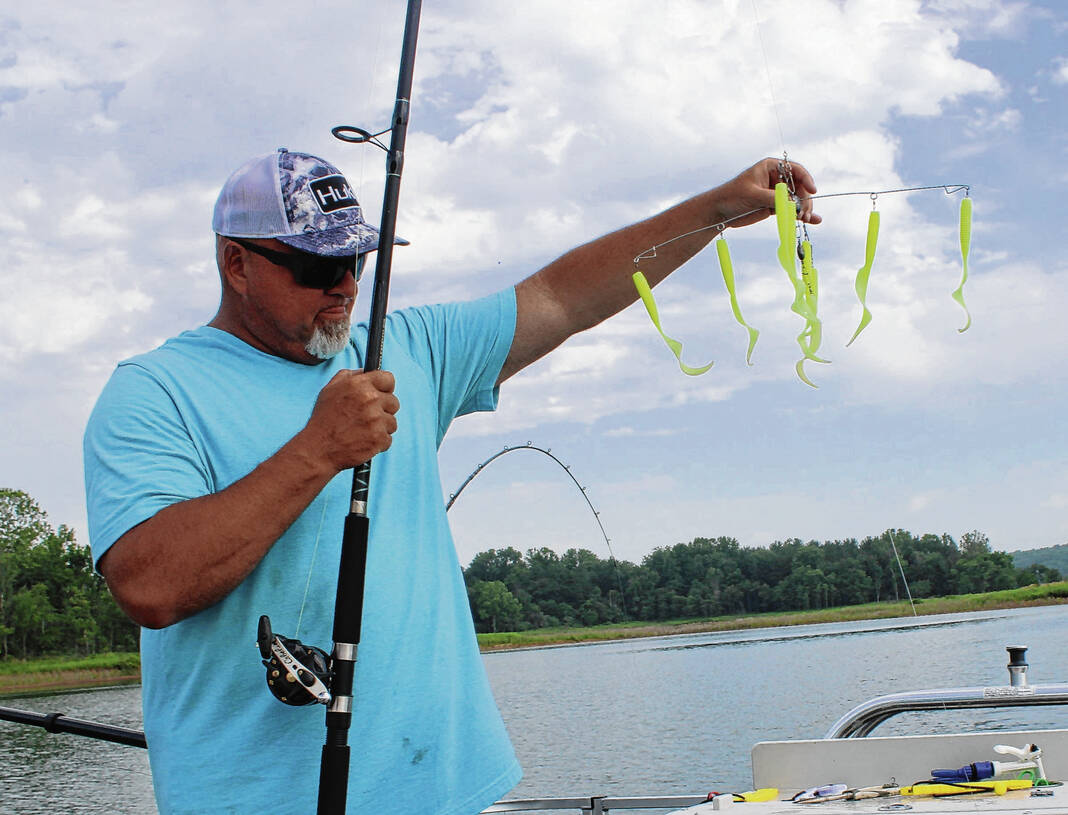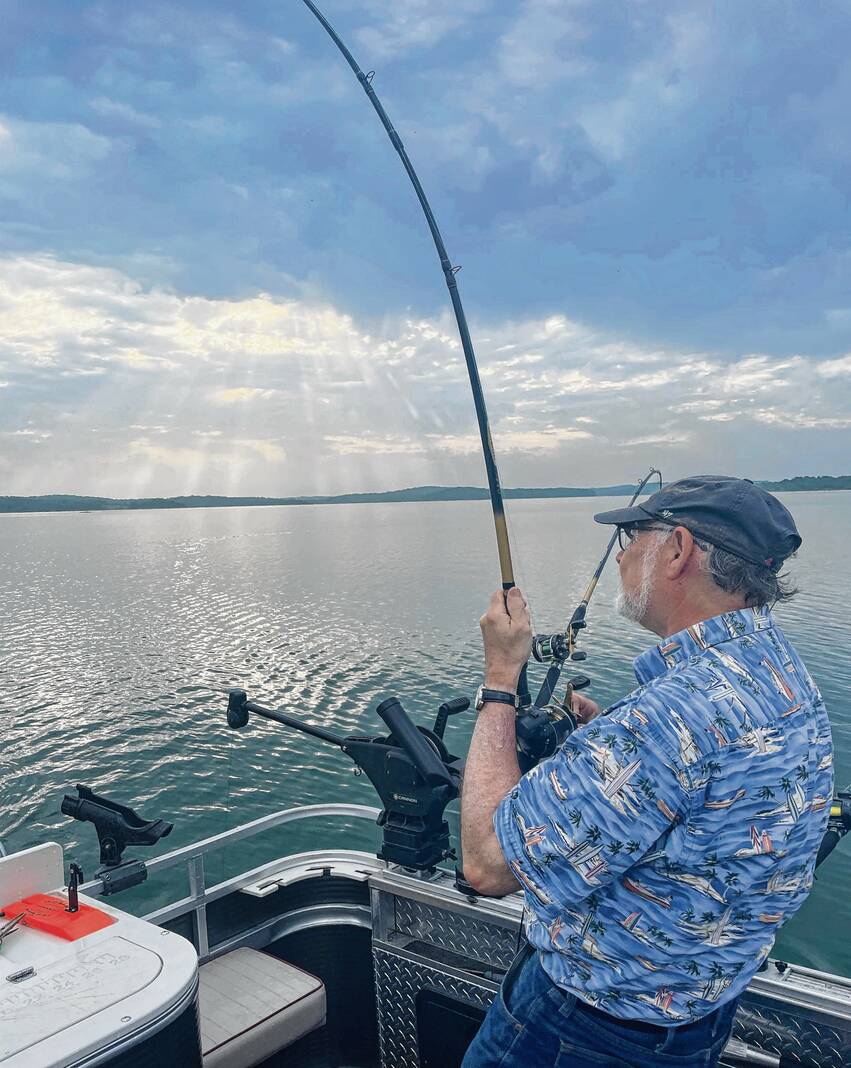BIRDSEYE — Newborn babies may weigh 8 pounds.
A gallon of water weighs 8 pounds.
So did the fat-boy hybrid striper I caught early on a sizzling hot day on Patoka Lake.
The fish wiggled and sloshed more, pitting survival instinct against a hook lodged in its mouth and my shoulder, arm and hand strength reeling it toward the boat. It felt heavier. And maybe that was because a second of the white bass-striper genre got tangled into the wrestling match, this one 5 pounds or so.
It was a double, two fish on, two fish fighting, two fish reeled in. Guide Kevin Hill of Wiper Sniper Charters provided instruction to pull high on the rod and reel low on the 20-pound test line as he stood by with a net.
“They’re stronger than any other fish in this lake,” Hill said.
When you groggily rise before dawn to go fishing, you hope the fish have also set their alarms. On this recent day, with few others boating on the 8,800-acre southern Indiana lake, they had. The fish actively participated in the angling to make the four-hour run a highlight of a three-day getaway visit to the state Department of Natural Resources property just 110 miles distant from Seymour.
Patoka Lake has 161 miles of shoreline and is renowned for its fishing opportunities. But its 25,800 acres, making it the largest IDNR property, include a plethora of nature and outdoor activities lure anglers’ families, too.
Too popular to be classified as a hidden gem, Patoka Lake, in fiscal 2020, attracted 657,000 visitors, according to a U.S. Corps of Engineers estimate. Estimates of the number of cars entering the park in the past have reached 1 million.
Patoka has diverse attractions. There are 455 Class A campground sites with electric service, plus 82 sites at a fisherman’s campground and seven backcountry sites, which are more rustic. As many spots as there are, it is still challenging to book a place for a summer weekend. Some rent cabins instead.
There is a beach facilitating swimming. There are hiking trails galore. Dedicated bird watchers are on the lookout for fresh species. Park authorities have identified at least 15 active eagle nests and 26 active osprey nests. There also may be accidental wildlife encounters in the woods.
Patoka Lake is actually a reservoir created by the Corps of Engineers in 1980 by damming 118 miles of the Patoka River. It was established as a source of secure drinking water and to guard against downriver flooding. Patoka sprawls across parts of three counties, Dubois, Crawford and Orange, and is the second largest Indiana reservoir behind Monroe Lake.
“In 2012, Patoka Lake was voted one of the 50 best places (in the country) to see wildlife,” said interpretive naturalist Dana Reckelhoff.
Reckelhoff listed wild critters from memory, neither in order of abundance nor alphabetical order: Turkeys, bobcats, box turtles, whitetail deer, coyotes, skunks (you may smell them first), opossum, raccoon, mink, squirrel, gray and red foxes and rabbits.
Reckelhoff whipped out a fishing regulation booklet and checked off the types of fish swimming in Patoka, including largemouth bass, smallmouth bass, those hybrid stripers, blue catfish, perch, black crappie, white crappie, bluegill and redear.
It would be more than a grand slam to catch all in a day.
Hill knows Patoka Lake holds a wide variety of fish. He is merely a hybrid striper aficionado, a specialist. He is a bruiser of a guy, and hybrids are bruisers of fish.
Even at 6:30 a.m., the humidity was as thick as maple syrup. The day was on its way to 97 degrees. Despite the sun burning, briefly, raindrops fell from sheer humidity. A saving element was cloud cover.
Hill drives a 22-foot pontoon boat. Guiding since 2015 after 30 years in law enforcement, he knows the contours of Patoka and the fish habits. He brought optimism to the water.
“We’re going to smoke ‘em,” he told me.
I have heard that before, but I never count my stripers before they are hatched.
We trolled with six rods, very sturdy sticks, to battle the stripers on an even playing field, four with downriggers and two “umbrella rods.” They were fancy lures, multiple yellow attractants that in a way also resembled lamp shades.
The boat motored out a few miles from Painter Creek.
“They’re the most aggressive fish,” Hill said of stripers. “They’re powerful. It’s the closest we get to an ocean fish.”
Large bubble pools appeared on the surface, representing schools of shad. The shad were yummy snacks for the stripers, so our aim was to cruise into the middle of the school and fool the fish. Sure enough, the ploy worked.
Two stripers rapid-fire took line. It required hustle and technique to reel the fish up to the boat. The first one was a 5-pounder.
“They’re going to be bigger than that,” Hill said. “You’ve got to be super-duper fast.”
I was more steady than swift but rarely slow enough to allow a determined striper to spit a hook.
Fishing at a water level of 17 feet, the stripers kept biting. I was quick enough to land two, and Hill brought in one.
“Three-banger,” he said.
Hill has occasionally seen hectic action with multiple fish grabbing lures simultaneously.
“I’m fine with two at a time,” he said. “It’s when you get three, four and five it gets crazy.”
We should be so lucky.
Hill said we should head for “the school bus,” an apparent reference to a school of stripers.
“We’ll see if they are playing hooky,” he said. Or would play with a hook.
Nope. But soon after, one fish stood out as a hard-fighting dude. I wrangled him to the boat, and it was an 18-inch walleye. Like his cousin, the stripers, we released that fish.
As the temperature rose on the hottest day of the year, we headed for shore, a quite satisfying return with nine hybrids and one walleye for me.
My wife, Debra, a very infrequent angler, and dog, Boston, joined me at a rental cabin close enough to the Patoka official entrance we could have thrown a baseball to it.
While there were many private summer homes nearby and hotels a dozen miles away in French Lick, we discovered a pet-friendly cabin in the woods with a screened-in porch and a barbecue grill. Cozy, yet spacious enough with all of the necessaries for cooking and reclining.
Owner Kevin Jenkins and his wife reside in the cabin during the colder half of the year and live on a 65-foot houseboat on Patoka during the warmer months.
We were close enough to visit French Lick Resort, though we skipped the fancy restaurant with its $27 hamburger. There are not a huge number of restaurants near Patoka, and if a visitor brought his own eats, with the exception of Schwartz Family Restaurant down the road in Eckerty, he wouldn’t be missing much.
If not for the Louisiana-like steamy air, we might have taken a hike. There are 1,000 acres of trails with one walk as short as a quarter-mile. Patoka also has a paved bicycle trail (baby strollers welcome) and a fitness trail where one can perform exercises along the way.
The Corps of Engineers dam at Patoka also features hiking trails. Reckelhoff said there are “beautiful views of the water and a view of the dam intake structure, the dam itself, the tailwaters and spillway,” reminders, she noted, of what makes Patoka a reservoir.
This particular day, there was a sparse crowd at the beach, although Patoka added 1,200 feet of new sand last year to combat erosion.
“Hopefully one day, we’ll add even more sand,” Reckelhoff said.
Patoka offers weekly archery shoots, an 18-hole disc golf course and hunting in season. Hard to complain about an Indiana resident $7 car entry fee. If you are bored at Patoka, it is your own fault.
Tom Todd, proprietor of Tom’s Guide Service, offers a different fishing experience on Patoka Lake. Using light tackle, 10-pound test, waving grubs and spinners from his 18-foot aluminum boat, Todd pursues black and white crappie and yellow bass.
It may have been melt-down weather, but a breeze kept Tom, Deb and I breathing on Patoka as we dropped lines to 20 feet or so, Deb for three hours, me for seven.
A longtime diesel fuel truck driver, Todd has guided since 2008. He eased out of competitive bass fishing in favor of taking a dozen grandchildren fishing, then turned to guiding. Once weighing north of 300 pounds, the 6-foot-6 Todd trimmed down to 200, to the point old friends don’t recognize him.
At first, the fish gravitated to Todd’s line. He lifted three out of the water quickly. Deb hit a yellow bass and easily brought it in. She added two more fish before retreating from the heat, but only after hooking my jeans. Tom hooked one of my shoelaces. And I hooked my backpack. I’ve never been mistaken for a yellow bass before.
Between casts, Todd and I made leisurely shifts to different fishing spots, distracted by eagle and osprey nests. An impressive osprey winged overhead.
Patoka is not just for Indiana residents. Surprised initially, Todd said he has guided many foreigners, including especially happy anglers from the Netherlands.
Reckelhoff said Patoka visitors “come from everywhere.” The visitor center’s registration book shows signers from many countries. Reckelhoff’s favorite foreigner story dates to around 2018. A husband and wife from Germany shipped an RV across the Atlantic Ocean and camped their way across the United States, camping at Patoka Lake.
Tom, who saw a deer that morning while readying his boat, guided us to a beaver dam. The structure was impressive, but the beaver a no-show. By the time we quit at 3 p.m., fish caught and released numbered 20, 12 by Tom, five by me, three by Deb.
Todd raved about a 1¼-pound white crappie I reeled in.
“That’s a rare crappie for this lake,” Todd said. “I guarantee there are people who fish this lake nearly every day that never caught one that big.”
Todd would know. Those old friends of his from the trucking world are a bit jealous about him spending so much time on splendid Patoka Lake.
They say, “’Boy, you’ve got it made,’” of Todd fishing every day. Tom Todd smiled and said, “Which I do.”

